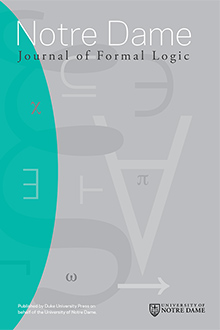We give modest upper bounds for consistency strengths for two well-studied combinatorial principles. These bounds range at the level of subcompact cardinals, which is significantly below a -supercompact cardinal. All previously known upper bounds on these principles ranged at the level of some degree of supercompactness. We show that by using any of the standard modified Prikry forcings it is possible to turn a measurable subcompact cardinal into and make the principle fail in the generic extension. We also show that by using Lévy collapse followed by standard iterated club shooting it is possible to turn a subcompact cardinal into and arrange in the generic extension that simultaneous reflection holds at , and at the same time, every stationary subset of concentrating on points of cofinality has a reflection point of cofinality .
Notre Dame J. Formal Logic
58(3):
409-432
(2017).
DOI: 10.1215/00294527-2017-0005
[2] Ben-David, S., and M. Magidor, “The weak $\square^{*}$ is really weaker than the full $\square$,” Journal of Symbolic Logic, vol. 51 (1986), pp. 1029–33.[2] Ben-David, S., and M. Magidor, “The weak $\square^{*}$ is really weaker than the full $\square$,” Journal of Symbolic Logic, vol. 51 (1986), pp. 1029–33.
[4] Caicedo, A. E., P. B. Larson, G. Sargsyan, R. D. Schindler, J. R. Steel, and M. Zeman, “Square principles in $\mathbb{P}_{\mathrm{max}}$ extensions,” to appear in Israel Journal of Mathematics, preprint, arXiv:1205.4275v2 [math.LO]. 1205.4275v2[4] Caicedo, A. E., P. B. Larson, G. Sargsyan, R. D. Schindler, J. R. Steel, and M. Zeman, “Square principles in $\mathbb{P}_{\mathrm{max}}$ extensions,” to appear in Israel Journal of Mathematics, preprint, arXiv:1205.4275v2 [math.LO]. 1205.4275v2
[5] Cummings, J., “Compactness and incompactness phenomena in set theory,” pp. 139–50 in Logic Colloquium 2001, vol. 20 of Lecture Notes in Logic, Association for Symbolic Logic, Urbana, Ill., 2005.[5] Cummings, J., “Compactness and incompactness phenomena in set theory,” pp. 139–50 in Logic Colloquium 2001, vol. 20 of Lecture Notes in Logic, Association for Symbolic Logic, Urbana, Ill., 2005.
[6] Cummings, J., “Iterated forcing and elementary embeddings,” pp. 775–883 in Handbook of Set Theory, edited by M. D. Foreman and A. Kanamori, Springer, Dordrecht, 2010.[6] Cummings, J., “Iterated forcing and elementary embeddings,” pp. 775–883 in Handbook of Set Theory, edited by M. D. Foreman and A. Kanamori, Springer, Dordrecht, 2010.
[11] Džamonja, M., and S. Shelah, “On squares, outside guessing of clubs and $I_{<f}[\lambda]$,” Fundamenta Mathematicae, vol. 148 (1995), pp. 165–98.[11] Džamonja, M., and S. Shelah, “On squares, outside guessing of clubs and $I_{<f}[\lambda]$,” Fundamenta Mathematicae, vol. 148 (1995), pp. 165–98.
[12] Foreman, M. D., and M. Magidor, “Large cardinals and definable counterexamples to the continuum hypothesis,” Annals of Pure and Applied Logic, vol. 76 (1995), pp. 47–97.[12] Foreman, M. D., and M. Magidor, “Large cardinals and definable counterexamples to the continuum hypothesis,” Annals of Pure and Applied Logic, vol. 76 (1995), pp. 47–97.
[13] Fuchs, G., “$\lambda$-Structures and $s$-structures: Translating the iteration strategies,” Annals of Pure and Applied Logic, vol. 162 (2011), pp. 710–51.[13] Fuchs, G., “$\lambda$-Structures and $s$-structures: Translating the iteration strategies,” Annals of Pure and Applied Logic, vol. 162 (2011), pp. 710–51.
[15] Gitik, M., “The negation of the singular cardinal hypothesis from $o(\kappa)=\kappa^{++}$,” Annals of Pure and Applied Logic, vol. 43 (1989), pp. 209–34. MR1007865 10.1016/0168-0072(89)90069-9[15] Gitik, M., “The negation of the singular cardinal hypothesis from $o(\kappa)=\kappa^{++}$,” Annals of Pure and Applied Logic, vol. 43 (1989), pp. 209–34. MR1007865 10.1016/0168-0072(89)90069-9
[17] Harrington, L., and S. Shelah, “Some exact equiconsistency results in set theory,” Notre Dame Journal of Formal Logic, vol. 26 (1985), pp. 178–88. MR783595 10.1305/ndjfl/1093870823 euclid.ndjfl/1093870823
[17] Harrington, L., and S. Shelah, “Some exact equiconsistency results in set theory,” Notre Dame Journal of Formal Logic, vol. 26 (1985), pp. 178–88. MR783595 10.1305/ndjfl/1093870823 euclid.ndjfl/1093870823
[25] Magidor, M., and C. Lambie-Hanson, “On the strengths and weaknesses of weak squares,” Appalachian Set Theory workshop, Carnegie Mellon University, Pittsburgh, Penn., 2011, http://www.math.cmu.edu/~eschimme/Appalachian/Magidor.html.[25] Magidor, M., and C. Lambie-Hanson, “On the strengths and weaknesses of weak squares,” Appalachian Set Theory workshop, Carnegie Mellon University, Pittsburgh, Penn., 2011, http://www.math.cmu.edu/~eschimme/Appalachian/Magidor.html.
[27] Mitchell, W. J., E. Schimmerling, and J. R. Steel, “The covering lemma up to a Woodin cardinal,” Annals of Pure and Applied Logic, vol. 84 (1997), pp. 219–55.[27] Mitchell, W. J., E. Schimmerling, and J. R. Steel, “The covering lemma up to a Woodin cardinal,” Annals of Pure and Applied Logic, vol. 84 (1997), pp. 219–55.
[30] Sargsyan, G., “Nontame mouse from the failure of square at a singular strong limit cardinal,” Journal of Mathematical Logic, vol. 14 (2014), no. 1450003.[30] Sargsyan, G., “Nontame mouse from the failure of square at a singular strong limit cardinal,” Journal of Mathematical Logic, vol. 14 (2014), no. 1450003.
[31] Sargsyan, G., HOD Mice and the Mouse Set Conjecture, vol. 236 of Memoirs of the American Mathematical Society, American Mathematical Society, Providence, 2015.[31] Sargsyan, G., HOD Mice and the Mouse Set Conjecture, vol. 236 of Memoirs of the American Mathematical Society, American Mathematical Society, Providence, 2015.
[32] Schimmerling, E., “Combinatorial principles in the core model for one Woodin cardinal,” Annals of Pure and Applied Logic, vol. 74 (1995), pp. 153–201. MR1342358 10.1016/0168-0072(94)00036-3[32] Schimmerling, E., “Combinatorial principles in the core model for one Woodin cardinal,” Annals of Pure and Applied Logic, vol. 74 (1995), pp. 153–201. MR1342358 10.1016/0168-0072(94)00036-3
[34] Schimmerling, E., and J. R. Steel, “The maximality of the core model,” Transactions of the American Mathematical Society, vol. 351 (1999), pp. 3119–41.[34] Schimmerling, E., and J. R. Steel, “The maximality of the core model,” Transactions of the American Mathematical Society, vol. 351 (1999), pp. 3119–41.
[39] Woodin, W. H., “Suitable extender models, I,” Journal of Mathematical Logic, vol. 10 (2010), pp. 101–339. MR2802084 10.1142/S021906131000095X[39] Woodin, W. H., “Suitable extender models, I,” Journal of Mathematical Logic, vol. 10 (2010), pp. 101–339. MR2802084 10.1142/S021906131000095X





